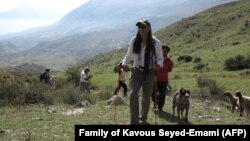The debate over environmentalists detained and accused of espionage in Iran has gained momentum after an MP called upon President Hassan Rouhani to personally step in.
As the head of Iran’s Supreme National Security Council (SNSC), “Rouhani should step in and end the row between the judiciary and the Islamic Revolutionary Guards Corps (IRGC) on one side and the Intelligence Ministry on the other,” Tehran MP Gholamreza Haydari said.
While the IRGC’s intelligence organization and judiciary insist the environmentalists were spies disguised as activists, Rouhani’s Intelligence Ministry maintains that they are innocent.
Rouhani’s allies have repeatedly noted that, according to the Iranian Constitution, espionage and counterespionage operations are the exclusive purview of the Intelligence Ministry and the IRGC has no legal right to interfere.
Judicial spokesman Gholam Hossein Mohseni-Eje’i, however, says the Intelligence Ministry is “not qualified to identify acts of espionage.”
Tehran MP Mahmud Sadeghi tweeted on May 9, “Based on indisputable evidence and documents, the Intelligence Ministry’s experts have explicitly declared that there is no proof for accusing the incarcerated environmentalists of espionage.”
Sadeghi said Intelligence Ministry officials were responding to pressure from conservative MPs to officially charge the alleged spies.
Pro-reform Sharq daily also reported on May 12, “The experts and specialists of the Intelligence Ministry have told MPs that the detained environmentalists were operating at least 60 kilometers (roughly 37 miles) from military sites and their cameras would not have been able to film them.”
Isa Kalantari, head of the Environment Department and a deputy of Rouhani’s, agreed that environmental cameras cannot be used for espionage purposes.
“Environmental cameras that monitor leopards’ activity have a range of no more than 50 meters (roughly 55 yards),” he said.
A senior military adviser of Khamenei’s went so far as to say the environmentalists could be using animals to spy. “In the context of hybrid warfare, every foreign tourist or environmentalist and scientist active in agricultural studies might be a spy,” Hasan Firouzabadi told the state-run Iran Labor News Agency (ILNA) in February.
He described an incident a few years ago in which they detained several individuals and confiscated suspicious “reptile desert species like lizards and salamanders,” which, after undergoing “studies,” showed that “the lizard-like animal skins attract nuclear waves.”
“They were nuclear spies who wanted to find out where we had uranium mines and where we were involved in atomic activities,” he said. “Many foreigners and Iranians who are involved in espionage are not even aware of the fact that they are actually spying.”
Sadeghi says the Intelligence Ministry claimed the environmentalists could have passed on “sensitive information” to third parties without being aware of their “wrongdoing.”
IRGC agents arrested several environmentalists in late January, including the Iranian-Canadian founder of Iran’s Wildlife Heritage, Kavous Seyed-Emami. Two weeks later, officials announced that Seyyd-Emami had committed suicide at Tehran’s notorious Evin Prison, a claim his family categorically rejected.
The IRGC apparatus expanded its dominance after the so-called reformist Mohammad Khatami won the presidential election in 1997. It has since detained scores of reformists and political and civil rights activists, including those associated with the Iran Freedom Movement.
Closely tied to Supreme Leader Ayatollah Ali Khamenei, the IRGC’s intelligence organization operates parallel to the Intelligence Ministry.
It played a pivotal role in suppressing widespread protests against the re-election of Mahmud Ahmadinejad in 2009. Khamenei then promoted the IRGC intelligence apparatus to the level of an organization practically on par with the Intelligence Ministry.
In one of the latest developments, the IRGC detained more than 40 environmentalists, rangers, and their relatives on May 7 and 8 in Hormozgan Province, reported the New York-based Center For Human Rights In Iran (CHRI).Rouhani has yet to respond to calls to step in or respond to an April 2 open letter signed by 800 Iranian environmentalists demanding that he clarify the fate of their peers.
Rouhani set up a fact-finding commission three months ago to investigate Seyed-Emami’s case and other suspicious deaths in custody, but it has yet to publish any findings.





